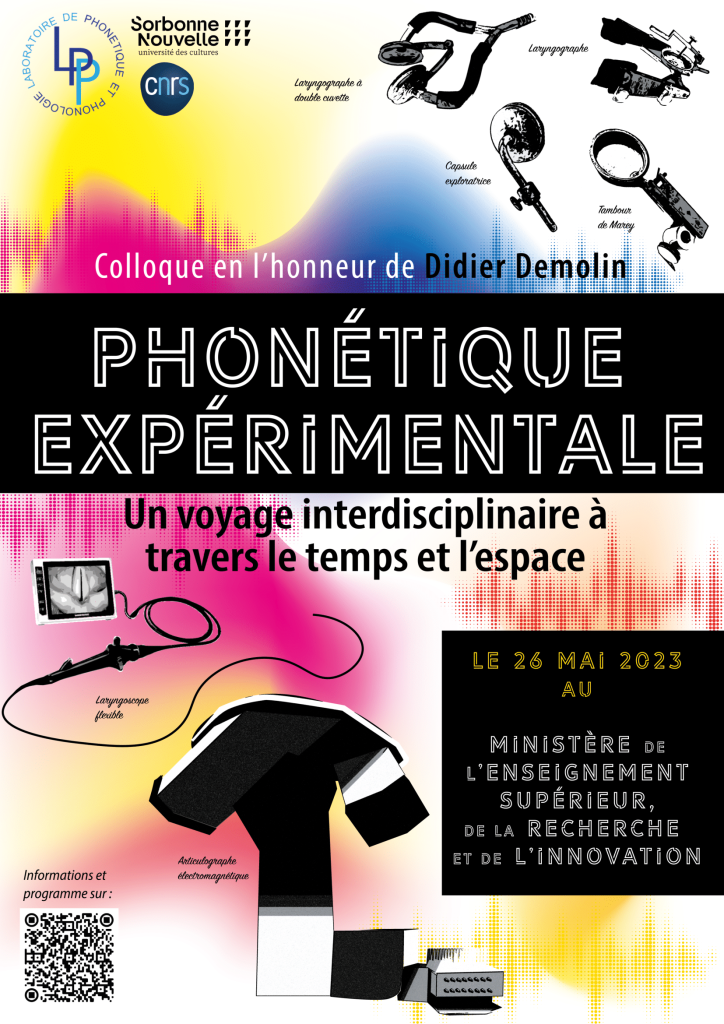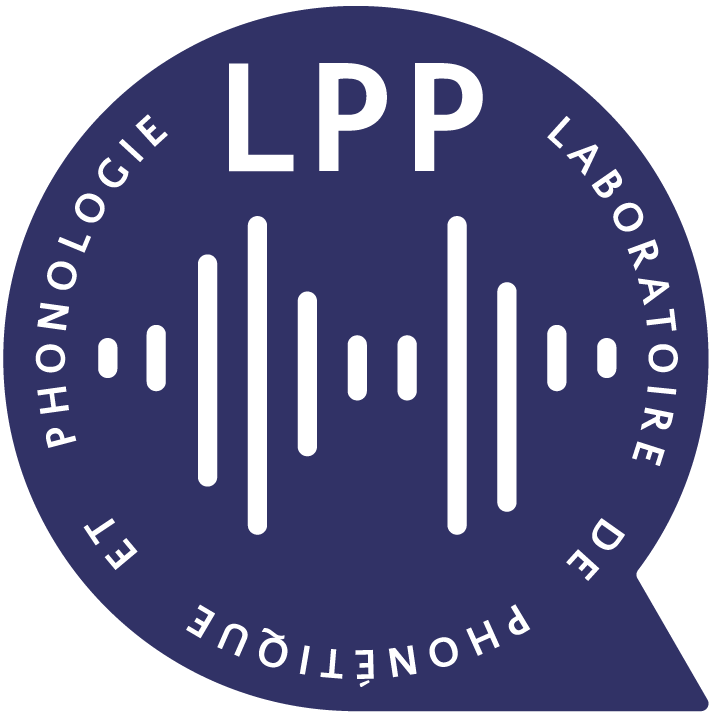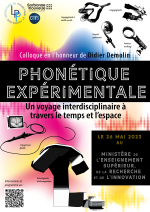Experimental phonetics:
an interdisciplinary journey through time and space

Celebration for Professor Didier Demolin
Paris, May 26, 2023
Professor Didier Demolin retired this year from his Full Professorship, which he had held since 2014 at Université Sorbonne Nouvelle.
He is a member of the Royal Academy of Overseas Sciences in Belgium and a member of the Europaea Academy.
His rich career has led him to stay and work in different laboratories and universities around the world and to lead fieldwork studies in Benin, Congo, Ethiopia, Tanzania, South Africa, as well as in Brazil and in many European countries.
His research interests have been equally varied in the fields of experimental, physiological and acoustic phonetics, comparative linguistics of world languages, musical acoustics and ethnomusicology…
Throughout his career, he has trained many young researchers and shared his enthusiasm and culture.
On Friday May 26, 2023, we shall be holding a scientific event in honour of his career and contributions to the field.
Participation is free and open to all, subject to availability of space for in-person participation.
If you are unable to attend this event in person, it will be possible to participate via video conference.
Location
The workshop will take place in Amphithéâtre Stoudzé, 25 rue de la Montagne Sainte Geneviève 75005 Paris, on the premises of the Ministry of Research.
Please note that you must be pre-registered and show an official ID to enter the building.
Program at a glance
Times displayed in this table are in Paris timezone (UTC+2). If you plan to follow the workshop online, you may check times in your timezone in the abstracts section.
09:45 |
Coffee (in front of Amphi Stourdzé) |
10:00 |
Welcome by the celebration’s organizers |
10:15-11:00 |
|
11:00-11:45 |
|
11:45-12:30 |
|
12:30-14:15 |
Lunch break (Hall Foch) |
14:30-15:15 |
|
15:15-16:00 |
|
16:00-16:45 |
|
16:45-18:00 |
Amiable farewell from Didier’s colleagues and former pupils |
18:00-18:30 |
Closing words: Professor Didier Demolin, « What is phonetics? What is a relevant speech sound? » |
19:00 |
Cocktail (Hall de la Poule) |
Abstracts
Format: Short talks: 30 min + 10 QA
Times are displayed in the following timezone :
2023-05-26 08:15 (UTC)
Jacqueline Vaissière (Université Sorbonne Nouvelle), « Demolin, Rousselot, Ohala et la phonétique expérimentale » (Jean-Pierre Rousselot, John Ohala and Didier Demolin and experimental phonetics)
Abbé Jean-Pierre Rousselot (Rousselot 1846-1924) is considered the founder of experimental phonetics. In 1896, Rousselot created the laboratory of experimental phonetics at the Collège de France and introduced the laboratory study of linguistic structures. He outlined the principles and experimental techniques of experimental laboratory in two volumes entitled « Principes de phonétique expérimentale » (Rousselot 1897-1908). Rousselot’s approach goes beyond phonetics in his insistence on the need to reproduce the observed phenomenon in laboratory conditions, under controlled conditions, to explain it. Rousselot encourages the development of experimental approaches in other parts of linguistics. The actual Labex EFL, “Empirical foundations of Linguistics” is completely in line with Rousselot’s point of view.
John Ohala and Didier Demolin are great admirers of Rousselot, most of whose writings they are familiar with. They espouse all of his ideas about the need to experiment and followed his boldness in applying all the techniques available at the time. John is generally regarded as Rousselot’s best successor. Both John and Didier regarded Rousselot as an intellectual father figure.
The three scientists share the necessity of integrating phonetics (the study of the sounds) and phonology (the study of the structures), contra phonologists proposing theories without experimental evidence and developing dynamics of phonological systems.
John and Didier share multiple collaborations or interests with other disciplines such as animal communication and evolution: Morton and Ohala’s frequency code, dressing the link between the expression of emotion in animals and human speech; Didier’s studies on the vocalizations and vocal morphology of Bonobos and chimpanzees, and showing the existence of syntax and recursion in non-human vocalizations, etc. One of Ohala’s main contributions is the illustration of the idea first expressed by Marguerite Durand that the listener is a source of change in sound, etc. Both John and Didier have disputed the claim about the contribution of subglottic pressure to Fo control (Glottal resistance, Fo, intensity, glottal opening, larynx height, and vocal fold tension). Both conduct adventurous experiments and direct measurements of subglottic pressure via tracheal puncture for this purpose. Both have studied different aspects of nasality, etc.
All three share a common interest in sound changes and in a number of languages, through the visit of researchers from different countries in Rousselot’s lab, South American, and African languages for Didier, with more fieldwork for Didier, on a particular aspect in the Mangbetu, Lendu, Mangbutu-Efe, Hendo, Hadza, Iraqw, Karitiana, Guarani, Nasa Yuwe, Namtrik, Muong and languages.
All three share a strong interest in instrumentation and methodologies from other disciplines and in the development of new instruments. All three contribute to the development of experimental methods in an innovative way. Ohala was the first to adapt the whole-body plethysmograph to the measurement of subglottic pressure in speech. He used the photoelectric thyroumbrometer for the measurement of laryngeal movements, the nasograph, etc., and EMG with an otolaryngologist to study the contribution of the intrinsic muscles and some extrinsic muscles of the larynx. Didier was the one who pioneered the use of MRI to study aspects of Bantu and French and was directly involved in the development of EVA (in Aix-en-Provence) and portable electromyography devices.
Special to Didier are 1) the special speech aerodynamics database, in line with Ferdinand Brunot’s archive, but with precious physiological data, 2) more effort to include factors such as sociolinguists in explaining the sound change in progress (Rousselot has insisted on sociolinguist factors, factors that Ohala put aside because they could not be studied in a laboratory, 3) more fieldwork, and 4) ethnomusicology.
2023-05-26 09:00 (UTC)
Jean-Marie Hombert (CNRS/Université Lumière Lyon 2), « Interacting with Didier Demolin for 40 years »
…
2023-05-26 09:45 (UTC)
Jody Kreiman (University of California, Los Angeles), « Labels for voices »
The problem of characterizing voice quality has long caused debate and frustration. The richness of the available descriptive vocabulary is overwhelming, but the density of information voices convey leads some to conclude that language can never adequately specify what we hear. Others argue that terminology lacks an empirical basis, so that language-based scales are inadequate a priori. Finally, efforts to link terms to acoustic signal characteristics have had limited success. On reexamination, however, some terms continually reappear across studies. These terms align with dimensions accounting for acoustic voice variance across speakers, and correlate with size and arousal across many species. This suggests that talk about voices rests on a bedrock of biology: We have evolved to perceive voices in terms of size/arousal, and these factors structure both voice acoustics and descriptive language. Such linkages could help integrate studies of signals and their meaning, producing a truly interdisciplinary approach to voice.
2023-05-26 12:30 (UTC)
John Kingston (University of Massachusetts), « Does order matter, and if so, how much and when? »
Does order matter, and if so, how much and when? The English words cat, tack, and act comprise all three of the phonotactically possible orders of the three phonemes, /k/, /æ/, and /t/. But it turns that such examples are exceeding rare. Inspection of the 8141 one-syllable English words in IPhOD2 consisting of 2-5 phonemes (Vaden, Halpin, & Hickok, 2009) showed that while the number of permutations of a word’s phonemes that make phonotactically possible words was reliably more than one, the number that were actual words was most often just one, i.e., the word itself. And the difference between the number of possible and actual words for any given set of phonemes was most often just one or two, which shows that although English phonotactics are permissive compared to those of many other languages, they still strictly constrain the phoneme orders that actually occur in the English lexicon. Recent eye tracking studies show that hearing one order of phonemes evokes words consisting of some other orders, e.g., hearing bus /b2s/ evokes sub /s2b/ (Toscano, Anderson, & McMurray, 2013), but hearing leaf /lif/ does not evoke flea /fli/ (Gregg, Inhoff, & Connine, 2019); see also Dufour & Grainger (2019) for similar results from French using long-distance priming in a lexical decision task. Taken together, these findings suggest a division in two of labor both between and within the lexicon and the phonotactics.
1. Lexicon. Irregular properties of words (morphemes):
• Lexicon 1 – out-of-time, underlying representations,
• Lexicon 2 – real-time, word-recognition or word-production, fine-grained phonetic detail;
2. Phonotactics (grammar). Regular properties:
• Phonotactics 1 – out-of-time, abstract mental grammar,
• Phonotactics 2 – real-time parsing grammar, which governs the performance of a speaker
or listener.
In the strongest hypothesis, phonemes can be unordered in many lexical 2 entries, because phono- tactics 2 regulate their order. Lexicon 2 underuses the orders permitted by phonotactics 2. Phono- tactics 2 are learned as words are learned, but acquire independence (McQueen, 1998). Using more of the orders permitted by a permissive language’s phonotactics would require listeners to attend to order information earlier in processing.
References
– Dufour, S., & Grainger, J. (2019). Phoneme-order encoding during spoken word recognition: A priming investigation. Cognitive Science, 43(10), e12785.
– Gregg, J., Inhoff, A. W., & Connine, C. M. (2019). Re-reconsidering the role in temporal order in spoken word recognition. Quarterly Journal of Experimental Psychology, 72(11), 2574-2583.
– McQueen, J. M. (1998). Segmentation of continuous speech using phonotactics. Journal of Memory
and Language, 39(1), 21-46.
– Toscano, J. C., Anderson, N. D., & McMurray, B. (2013). Reconsidering the role of temporal order
in spoken word recognition. Psychonomic Bulletin & Review, 20(5), 981-987.
– Vaden, K. I., Halpin, H. R., & Hickok, G. S. (2009). Irvine phonotactic online dictionary, version
2.0.
2023-05-26 13:15 (UTC)
Hans Van de Velde (Fryske Akademy), « Rhotic present for Didier: an automatic tool for the transcription of r »
Rhotics display a large amount of variation, both between and within languages. Consequently, r-sounds often show up as sociolinguistic variables between and within speech communities. Until the 1990’s, sociolinguists mainly worked with broad categories, such as alveolar vs. uvular or full (whatever that may be) vs. reduced vs. deleted. However, in work on Dutch, the need was felt for a more fine-grained approach to identify the numerous variants and to understand their relationship in order to get a grip on processes of language variation and change in past and present. Not surprisingly, if there are complex problems and ‘bizar’ sounds, Didier Demolin shows up, in all corners of the world. In 2001 he presented his first phonetic and phonological insights of r in Belgian French (Demolin 2001). For more than 20 years Didier and I have been working on Dutch r and discussing the relationship between alveolar and uvular trills. Finally, we think to understand the articulatrory and acoustic mechanisms underlying the change of r->R (Van de Velde & Demolin 2021, Demolin & Van de Velde submitted).
Sebregts (2015) distinguished 20 variants in Dutch, after a time-consuming transcription process combining perceptual and acoustic cues. The data set contains 22000 items equally distributed over 408 speakers from four urban centres in Flanders and six in the Netherlands. This data set and machine learning techniques will be used to develop and test a tool for the automatic classification of r-variants, that will be presented on the occasion of this symposium.
References
– Demolin, Didier (2001). Some phonetic and phonological observations concerning /R/ in Belgian French. In Hans Van de Velde et Roeland Van Hout (eds.). ‘r-atics: Sociolinguistic, phonetic and phonological characteristics of /r/, 63-73. Bruxelles: Etudes & Travaux – ILVP/ULB.
– Sebregts, Koen. 2015. The sociophonetics and phonology of Dutch r. LOT.
– Van de Velde, Hans & Didier Demolin. 2021. From alveolar [r] to uvular [R]: The symbiosis of dialectology, sociolinguistics, phonetics and phonology to explain sound change in progress. In Adolfo Arejita (ed.), Aniztasuna: Hizkeren berba-mintzoak, 289-304. Bilbao: Euskaltzaindia.
2023-05-26 14:00 (UTC)
Sergio Hassid (Hôpital Universitaire de Bruxelles), « Historical review of working with Didier »
…
Le comité organisateur du Laboratoire de Phonétique et Phonologie
Rosario Signorello, Lise Crevier-Buchman, Claire Pillot-Loiseau, Nicolas Audibert, Leonardo Lancia, Alexis Dehais-Underdown, Clara Ponchard, Cecile Fougeron, et Cedric Gendrot



